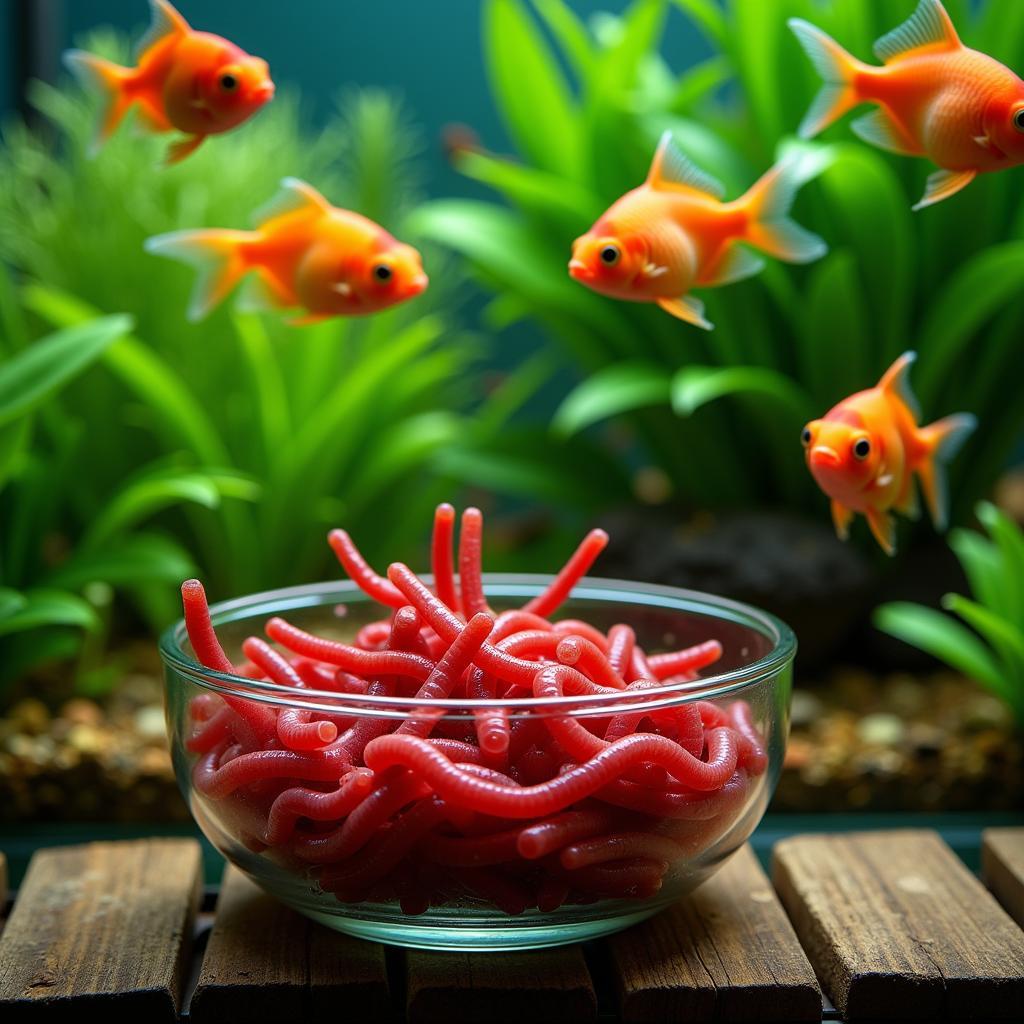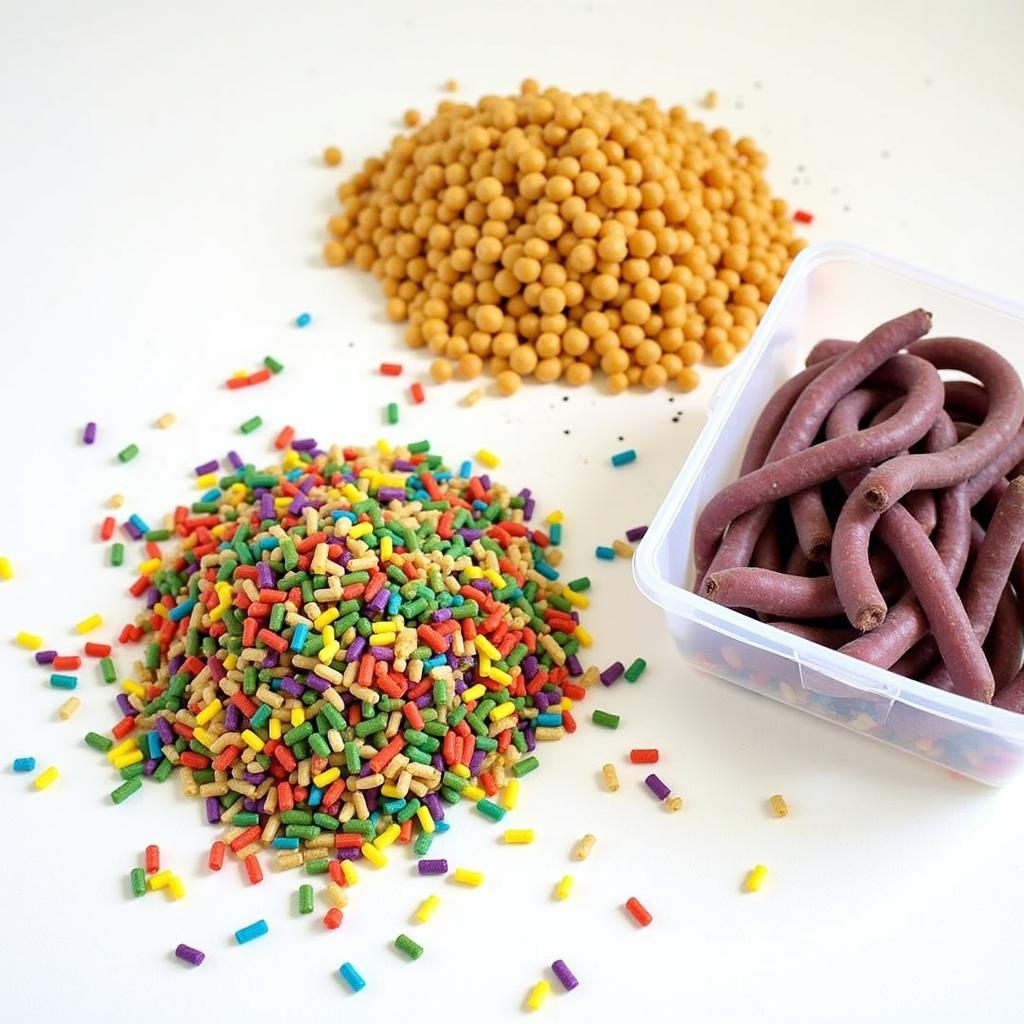Live blood worms are a popular choice among aquarium enthusiasts looking to provide their fish with a nutritious and stimulating meal. These small, red worms wriggle enticingly, triggering a natural feeding response in many fish species. But are live blood worms truly the ultimate fish food, or are there important considerations to keep in mind? Let’s delve into the world of live blood worms and discover their benefits, potential risks, and best practices for use.
Discus enthusiasts often utilize high-protein diets, much like what you’d find when researching discus fish food. Live blood worms are a rich source of protein, essential for muscle development and overall health. They also contain valuable vitamins and minerals, contributing to a well-rounded diet. The wriggling motion of live blood worms stimulates natural hunting instincts, enriching the feeding experience for your aquatic companions. This can be especially beneficial for picky eaters or fish recovering from illness.
Benefits of Live Blood Worms
Live blood worms offer several advantages as a fish food:
- High in protein: Crucial for growth and repair.
- Palatability: Their wriggling movement is highly attractive to most fish.
- Nutritional value: Contains essential vitamins and minerals.
- Stimulates natural feeding behaviors: Encourages activity and reduces boredom.
However, it’s important to note that live food can sometimes introduce parasites or diseases into your aquarium. Therefore, sourcing your live blood worms from a reputable supplier is paramount.
 Live Blood Worms in Aquarium Fish Tank
Live Blood Worms in Aquarium Fish Tank
Sourcing and Storing Live Blood Worms
Purchasing live blood worms from a trusted source, such as a reputable aquarium store or online vendor, is crucial. This minimizes the risk of introducing harmful pathogens into your tank. Be wary of cheap, unrefrigerated blood worms, as these can carry parasites. When you bring your live blood worms home, proper storage is key to maintaining their freshness and nutritional value. Refrigeration is essential for preserving live blood worms. Keep them at a cool temperature, ideally between 35-40°F (2-4°C). Avoid freezing, as this can damage the worms and diminish their nutritional content.
Feeding Live Blood Worms to Your Fish
While live blood worms offer a nutritional boost, they shouldn’t constitute the sole component of your fish’s diet. Consider them a supplemental treat, offered alongside a high-quality staple food. Overfeeding can lead to digestive issues and water quality problems. Start by offering a small amount of live blood worms and observe your fish’s feeding response. Remove any uneaten worms after a few minutes to prevent them from decaying and impacting water quality.
Alternatives to Live Blood Worms
If you’re concerned about the potential risks associated with live food, several alternatives provide similar nutritional benefits:
- Frozen blood worms: A convenient and safe option, retaining much of the nutritional value of live worms.
- Freeze-dried blood worms: Another safe alternative, although less palatable than frozen or live worms.
- High-protein flake or pellet foods: Offer a balanced diet and can be supplemented with other treats. For examples, check out our recommended fish food brands.
Are Live Blood Worms Right for Your Fish?
Whether live blood worms are the best choice for your fish depends on several factors, including the species of fish you keep, your comfort level with handling live food, and your ability to source them responsibly. Looking for a high protein alternative? Perhaps our guide on high protein fish food can help.
“Choosing the right food for your fish is crucial for their health and well-being,” says Dr. Amelia Reed, aquatic veterinarian. “Live blood worms can be a valuable addition to a balanced diet, but always prioritize quality and safe handling practices.”
 Various Types of Fish Food: Flakes, Pellets, and Frozen
Various Types of Fish Food: Flakes, Pellets, and Frozen
Conclusion
Live blood worms can be a valuable addition to your fish’s diet, offering a nutritional boost and stimulating their natural feeding instincts. However, responsible sourcing, proper storage, and careful feeding practices are essential to minimize potential risks. By following these guidelines, you can safely incorporate live blood worms into your fish-keeping routine and provide your aquatic companions with a varied and enriching diet. Can you use goldfish food for bettas? Find out in our article on can you feed a betta goldfish food. Remember to always prioritize the health and well-being of your fish when making decisions about their diet.
FAQ
- How often should I feed live blood worms?
- Can I culture live blood worms at home?
- Are live blood worms suitable for all fish species?
- What are the signs of parasite infestation in fish?
- How can I tell if my live blood worms are fresh?
- What are some other good live food options for fish?
- How do I dispose of uneaten live blood worms?
Are there local food banks that can help with pet food? Check our resource on fish food pantry lockport. We’ve also compiled helpful articles on various fish species and their dietary needs. Check out our blog for more information!
When you need assistance, please contact Phone Number: 02437655121, Email: minacones@gmail.com or visit us at: 3PGH+8R9, ĐT70A, thôn Trung, Bắc Từ Liêm, Hà Nội, Việt Nam. We have a 24/7 customer support team.